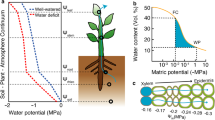Summary
The short term effects of irrigation on diurnal changes in Ψleaf and titratable acidity were examined both inSempervivum montanum and inSedum album, a facultative CAM plant, in the Spanish Pyrenees. InSemperivivum, Ψleaf responded rapidly to irrigation and, in both the control and irrigated plants, increased during the day and decreased during the night and early morning. By contrast, Ψleaf inSedum responded more slowly to irrigation and showed a decrease during the day and an increase in the period between evening and early morning. Under the conditions of the short-term experiments, changes in acid metabolism were not observed in either species following irrigation. The results suggest that transpirational water loss together with redistribution of water within the plant are more important than the osmotic concentration of malic acid in determining Ψleaf in both species and that daytime water loss is greater inSedum than inSempervivum.
The effect of long-term water stress on Ψleaf and acid levels was also assessed in both species over a 3-week period. Both Ψleaf and acidification inSempervivum decreased over this time period but could, at least partially, be reversed by irrigation. InSedum, Ψleaf also declined but a more gradual reduction in acidification occurred than inSempervivum. Irrigation inSedum at least partially reversed the decline in Ψleaf but produced a complex pattern of acid metabolism. Nocturnal acidification in the irrigated plants was lower than in the non-irrigated control when preceded by a cool day but showed complete recovery following a hot day. It is suggested inSedum album that C3 photosynthesis during the preceding light period, as determined by light intensity and leaf temperature, may be important in determining the extent of nocturnal acidification under field conditions.
Similar content being viewed by others
References
Acevedo E, Bodilla I, Nobel PS (1983) Water relations, diurnal acidity changes, and productivity of a cultivated cactus,Opuntia ficus-indica. Plant Physiol 72:775–780
Begg JE, Turner NC (1976) Crop water deficits. Adv Agron 28:161–217
Gerwick BC, Williams GJ (1978) Temperature and water regulation of gas exchange ofOpuntia polyacantha. Oecologia (Berlin) 35:149–159
Hartsock TL, Nobel PS (1976) Watering converts a CAM plant to daytime CO2 uptake. Nature 262:574–576
Hnatiuk RJ, Smith JMB, McVean DN (1976) The climate of Mount Wilhelm. Mount Wilhelm Studies 2. ANU BG/4 Canberra
Joshi MC, Boyer JS, Kramer PJ (1965) Growth, carbon dioxide exchange, transpiration and transpiration ratio of pineapple. Bot Gaz 126:174–179
Kluge M (1977) IsSedum acre a CAM plant? Oecologia (Berlin) 29:77–83
Kluge M (1978) Ecological aspects of crassulacean acid metabolism (CAM). In: DO Hall, J Coombs, TW Goodwin (eds) Proc 4th Internat Congress of Photosynthesis. Biochem Soc, London; pp 335–344
Kluge M, Ting IP (1978) Crassulacean acid metabolism. Ecological studies, Vol 16. Springer, Berlin Heidelberg New York
Lange OL, Schulze E-D, Kappen L, Evenari M, Buschbom U (1975) CO2 exchange pattern under natural conditions ofCaralluma negevensis, a CAM plant of the Negev Desert. Photosynthetica 9:318–326
Larcher W, Wagner J (1983) Ökologischer Zeigerwert und physiologische Konstitution vonSempervivum montanum. Verhandlungen der Gesellschaft für Ökologie, Festchrift Ellenberg, Band XI, pp 253–264
Lüttge U, Ball E (1977) Water relation parameters of the CAM plantKalanchoë daigremontiana in relation to diurnal malate oscillations. Oecologia (Berlin) 31:85–94
Lüttge U, Kluge M, Ball E (1975) Effects of osmotic gradients on vacuolar malic acid storage. A basic principle in oscillatory behaviour of crassulacean acid metabolism. Plant Physiol 56:613–616
Lüttge U, Smith JAC, Mariago G (1982) Membrane transport, osmoregulation, and the control of CAM. In: IP Ting, M Gibbs (eds) Crassulacean acid metabolism. Amer Soc of Plant Physiologists, Baltimore, pp 69–91
Nobel PS (1976) Water relations and photosynthesis of a desert CAM plant,Agave deserti. Plant Physiol 58:576–582
Nobel PS (1977) Water relations and photosynthesis of a barrel cactus,Ferocactus acanthodes. Oecologia (Berlin) 27:117–133
Osmond CB (1978) Crassulacean acid metabolism: a curiosity in context. Ann Rev Plant Physiol 29:379–414
Osmond CB, Ziegler H, Stichler W, Trimborn P (1975) Carbon isotope discrimination in alpine succulent plants supposed to the capable of crassulacean acid metabolism. Oecologia (Berlin) 18:209–217
Osmond CB, Nott DL, Firth PM (1979) Carbon assimilation patterns and growth of the introduced CAM plantOpuntia inermis in Eastern Australia. Oecologia (Berlin) 40:331–350
Osmond CB, Winter K, Ziegler H (1982) Functional significance of different pathways of CO2 fixation in photosynthesis. In: OL Lange, PS Nobel, CB Osmond, H Ziegler (eds) Encycl of Plant Physiol, New Series, Vol 12B. Springer, Berlin Heidelberg New York, pp 479–547
Patten DT, Dinger BE (1969) Carbon dioxide exchange patterns of cacti from different environments. Ecology 50:686–688
Schuber M, Kluge M (1981) In situ studies on crassulacean acid metabolism inSedum acre L. andSedum mite Gil. Oecologia (Berlin) 50:82–87
Steudle E, Smith JAC, Lüttge U (1980) Water-relation parameters of individual mesophyll cells of the crassulacean acid metabolism plantKalanchoë daigremontiana. Plant Physiol 66:1155–1163
Szarek SR, Ting IP (1975) Physiological responses to rainfall inOpuntia basilaris (Cactaceae). Amer J Bot 62:602–609
Ting IP, Rayder L (1982) Regulation of C3 to CAM shifts. In: IP Ting, M Gibbs (eds) Crassulacean acid metabolism. Amer Soc of Plant Physiologists, Baltimore, pp 193–207
Troughton JH (1979) δ13C as an indicator of carboxylation reactions. In: M Gibbs, E Latzko (eds) Photosynthesis II: photosynthetic carbon metabolism. Encycl Plant Physiol, New Series, Vol 6. Springer, Berlin Heidelberg New York, pp 140–147
Willert DJ von, Treichel S, Kirst GO, Curdts E (1976) Environmentally controlled changes of photoenolpyruvate carboxylases inMesembryanthemum. Phytochemistry 15:1435–1436
Wagner J, Larcher W (1981) Dependence of CO2 gas exchange and acid metabolism of the alpine CAM plantSempervivum montanum on temperature and light. Oecologia (Berlin) 50:88–93
Winter K, Lüttge U, Winter E, Troughton JH (1978) Seasonal shift from C3 photosynthesis to crassulacean acid metabolism inMesembryanthemum crystallinum growing in its natural environment. Oecologia (Berlin) 34:225–237
Author information
Authors and Affiliations
Rights and permissions
About this article
Cite this article
Earnshaw, M.J., Carver, K.A. & Lee, J.A. Changes in leaf water potential and CAM inSempervivum montanum andSedum album in response to water availability in the field. Oecologia 67, 486–492 (1985). https://doi.org/10.1007/BF00790018
Received:
Issue Date:
DOI: https://doi.org/10.1007/BF00790018




